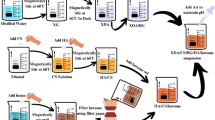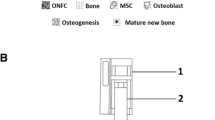Abstract
This study aimed at preparation and in vitro and in vivo evaluation of novel bioactive, biodegradable, and antibacterial nanocomposite coating for the improvement of stem cells attachment and antibacterial activity as a candidate for dental implant applications. Poly (lactide-co-glycolide)/bioactive glass/hydroxyapatite (PBGHA) nanocomposite coating was prepared via solvent casting process. The nanoparticle amounts of 10, 15, and 20 weight percent (wt%) were chosen in order to determine the optimum amount of nanoparticles suitable for preparing an uniform coating. Bioactivity and degradation of the coating with an optimum amount of nanoparticles were evaluated by immersing the prepared samples in simulated body fluid and phosphate buffer saline (PBS), respectively. The effect of nanocomposite coating on the attachment and viability of human adipose-derived stem cells (hASCs) was investigated. Kirschner wires (K-wires) of stainless steel were coated with the PBGHA nanocomposite coating, and mechanical stability of the coating was studied during intramedullary implantation into rabbit tibiae. The results showed that using 10 wt% nanoparticles (5 wt% HA and 5 wt% BG) in the nanocomposite could provide the desired uniform coating. The study of in vitro bioactivity showed rapid formation of bone-like apatite on the PBGHA coating. It was degraded considerably after about 60 days of immersion in PBS. The hASCs showed excellent attachment and viability on the coating. PBGHA coating remained stable on the K-wires with a minimum of 96% of the original coating mass. It was concluded that PBGHA nanocomposite coating provides an ideal surface for the stem cells attachment and viability. In addition, it could induce antibacterial activity, simultaneously.








Similar content being viewed by others
References
Fathi MH, Doostmohammadi A. Bioactive glass nanopowder and bioglass coating for biocompatibility improvement of metallic implant. J Mater Process Tech. 2009;209:1385–91.
Fathi MH, Doost Mohammadi A. Preparation and characterization of sol–gel bioactive glass coating for improvement of biocompatibility of human body implant. Mater Sci Eng A. 2008;474(1–2):128–33.
Ninomi M. Mechanical properties of biomedical titanium alloys. Mater Sci Eng A. 1998;242:231–6.
Faghihi S, Azari F, Li H, Bateni MR, Szpunar JA, Vali H, Tabrizian M. The significance of crystallographic texture of titanium alloy substrates on pre-osteoblast responses. Biomaterials. 2006;27:3532–9.
Ning C, Zhou Y. Correlations between the in vitro and in vivo bioactivity of the Ti/HA composites fabricated by a powder metallurgy method. Acta Biomater. 2008;4:1944–52.
Fathi MH, Salehi M, Saatchi A, Mortazavi V, Mosavi SB. In vitro corrosion behavior of bioceramic, metallic, and bioceramic–metallic coated stainless steel dental implants. Dent Mater. 2003;19:188–98.
Bai X, Sandukas S, Appleford MR, Ong JL, Rabiei A. Deposition and investigation of functionally graded calcium phosphate coatings on titanium. Acta Biomater. 2009;5(9):3563–72.
Raschke M, Wildemann B, Inden P, Bail H, Flyvbjerg A, Hoffmann J, Haas NP, Schmidmaier G. Insulin-like growth factor-1 and transforming growth factor-beta1 accelerates osteotomy healing using polylactide-coated implants as a delivery system: a biomechanical and histological study in minipigs. Bone. 2002;30(1):144–51.
Schmidmaier G, Wildemann B, Ball H, Lucke M, Fuchs T, Stemberger A, Flyvbjerg A, Haas NP, Raschke M. Local application of growth factors (insulin-like growth factor-1 and transforming growth factor-beta1) from a biodegradable poly(d, l-lactide) coating of osteosynthetic implants accelerates fracture healing in rats. Bone. 2001;28(4):341–50.
Gollwitzer H, Ibrahim K, Meyer H, Mittelmeier W, Busch R, Stemberger A. Antibacterial poly(d, l-lactic acid) coating of medical implants using a biodegradable drug delivery technology. J Antimicrob Chemoth. 2003;51:585–91.
Price JS, Tencer AF, Arm DM, Bohach GA. Controlled release of antibiotics from coated orthopedic implants. J Biomed Mater Res. 1996;30:281–6.
Cochran DL, Schenk RK, Lussi A, Higginbottom FL, Buser D. Bone response to unloaded and loaded titanium implants with a sandblasted and acid-etched surface: a histometric study in the canine mandible. J Biomed Mater Res. 1998;40:1–11.
Guéhennec L, Soueidan A, Layrolle P, Amouriq Y. Surface treatments of titanium dental implants for rapid osseointegration. Dent Mater. 2007;23:844–54.
Paital SR, Dahotre NB. Wettability and kinetics of hydroxyapatite precipitation on a laser-textured Ca–P bioceramic coating. Acta Biomater. 2009;5(7):2763–72.
Blind O, Klein LH, Dailey B, Jordan L. Characterization of hydroxyapatite films obtained by pulsed-laser deposition on Ti and Ti-6AL-4 V substrates. Dent Mater. 2005;21:1017–24.
Brunski J. An Introduction to Material in Medicine. London: Academic Press; 1996. p. 37.
Hench LL. Bioceramics. J Am Ceram Soc. 1998;81:1705–27.
Peitl O, Oréfice RL, Hench LL, Brennan AB. Effect of the crystallization of bioactive glass reinforcing agents on the mechanical properties of polymer composites. Mater Sci Eng A. 2004;372:245–51.
Kokubo T. Novel bioactive materials. Anales de Quimica Int Ed. 1997;93:S49–55.
Hench LL, Kokubo T. In: Black J, Hastings G (Eds) Handbook of biomaterial properties, Part II (6). London: Chapman & Hall; 1988.
Xynos ID, Edgar AJ, Buttery LDK, Hench LL, Polak JM. Ionic dissolution products of bioactive glass increase proliferation of human osteoblasts and induce insulin-like growth factor II mRNA expression and protein synthesis. Biochem Bioph Res Co. 2000;276:461–5.
Stoor P, Soderling E, Salonen JI. Antibacterial effect of a bioactive glass paste on oral microorganisms. Acta Orthop Scand. 1998;56:161–5.
Allan I, Newman H, Wilson M. Antibacterial activity of particulate Bioglass® against supra- and sub-gingival bacteria. Biomaterials. 2001;2:1683–7.
Munukka E, Lepparanta O, Korkeamaki M, Vaahtio M, Peltola T, Zhang D, Hupa L, Ylanen H, Salonen JI, Viljanen MK, Eerola E. Bactericidal effects of bioactive glasses on clinically important aerobic bacteria. J Mater Sci Mater Med. 2008;19:27–32.
Waltimo T, Brunner TJ, Vollenweider M, Stark WJ, Zehnder M. Antimicrobial effect of nanometric bioactive glass 45S5. J Dent Res. 2007;86:754–7.
Mortazavi V, Mehdikhani Nahrkhalaji M, Fathi MH, Mousavi SB, Nasr Esfahani B. Antibacterial effects of sol–gel-derived bioactive glass nanoparticle on aerobic bacteria. J Biomed Mater Res. 2010;94A:160–8.
Lin HR, Kuo CJ, Yang CY, Shaw SY, Wu YJ. Preparation of macroporous biodegradable PLGA scaffolds for cell attachment with the use of mixed salts as porogen additives. J Biomed Mater Res. 2002;63:271–9.
Li H, Chang J. pH-compensation effect of bioactive inorganic fillers on the degradation of PLGA. Compos Sci Technol. 2005;65:2226–32.
Hollinger JO. Preliminary report on the osteogenic potential of a biodegradable copolymer of polyactide (PLA) and polyglycolide (PGA). J Biomed Mater Res. 1983;17:71–82.
Sato M, Slamovicha EB, Webster TJ. Enhanced osteoblast adhesion on hydrothermally treated hydroxyapatite/titania/poly(lactide-co-glycolide) sol–gel titanium coatings. Biomaterials. 2005;26:1349–57.
Berbecaru C, Alexandru HV, Stan GE, Marcov DA, Pasuk I, Ianculescu A. First stages of bioactivity of glass–ceramics thin films prepared by magnetron sputtering technique. Mater Sci Eng B. 2010;169:101–5.
Stan GE, Pina S, Tulyaganov DU, Ferreira JMF, Pasuk I, Morosanu CO. Biomineralization capability of adherent bio-glass films prepared by magnetron sputtering. J Mater Sci Mater Med. 2009;21:1047–55.
Zuk PA, Zhu M, Mizuno H, Huang J, Futrell JW, Katz AJ, Benhaim P, Lorenz HP, Hedrick MH. Multilineage cells from human adipose tissue: implications for cell-based therapies. Tissue Eng. 2001;7:211–28.
Hauner H, Entenmann G, Wabitsch M, Gaillard D, Ailhaud G, Negrel R, Pfeiffer EF. Promoting effect of glucocorticoids on the differentiation of human adipocyte precursor cells cultured in a chemically defined medium. J Clin Invest. 1989;84:1663–70.
Thapa A, Webster TJ, Haberstroh KM. Polymers with nano-dimensional surface features enhance bladder smooth muscle cell adhesion. J Biomed Mater Res A. 2003;67(4):1374–83.
Puleo DA, Nanci A. Understanding and controlling the bone-implant interface. Biomaterials. 1999;20:2311–21.
Gollwitzer H, Thomas P, Diehl P, Steinhauser E, Summer B, Barnstorf S, Gerdesmeyer L, Mittelmeier W, Stemberger A. Biomechanical and allergological characteristics of a biodegradable poly(d, l-lactic acid) coating for orthopaedic implants. J Orthop Res. 2005;23:802–9.
Chang CK, Wu JS, Mao DL, Ding CX. Mechanical and histological evaluations of hydroxyapatite-coated and noncoated Ti6Al4 V implants in tibia bone. J Biomed Mater Res. 2001;56:17–23.
Suh WH, Suslick KS, Stucky GD, Suh YH. Nanotechnology, nanotoxicology, and neuroscience. Prog Neurobiol. 2009;87:133–70.
Baroni T, Bodo M, Conte C, Muzzi G, Lumare A, Abbrutti G. Silica and its antagonist effect in TGF-beta in lung fibroblasts. J Invest Med. 2001;49:146–56.
Calomme MR, Vanden-Berghe DA. Effect of the Si, Ca, Mg and P concentrations in serum and the collagen concentration in skin and cartilage. Biol Trace Element Res. 1997;56:153–65.
Pham KN, Fullston D, Sagoe-Crentsil K. Surface modification for stability of nanosized silica colloids. J Colloid Interf Sci. 2007;315:123–7.
Yang YN, Zhang HX, Wang P, Zheng QZ, Li J. The influence of nanosized TiO2 fillers on the morphologies and properties of PSFUF membrane. J Member Sci. 2007;288:231–8.
Tancred DC, McCormack BAO, Carr AJ. A synthetic bone implant macroscopically identical to cancellous bone. Biomaterials. 1998;19:2303–11.
Yaszemski MJ, Trantolo DJ, Lewandrowski KU, Hasirci V, Altobelli DE, Wise DL. Biomaterials in orthopedics, Part. III. New York: Marcel Dekker, Inc; 2004. p. 401–23.
Albrektsson T, Johansson C. Osteoinduction, osteoconduction and osseointegration. Eur Spine J. 2001;10:S96–101.
Gastaldi G, Asti A, Scaffino MF, Visai L, Saino E, Cometa AM, Benazzo F. Human adipose-derived stem cells (hASCs) proliferate and differentiate inosteoblast-like cells on trabecular titanium scaffolds. J Biomed Mater Res A. 2010;94(3):825–32.
Ngiam M, Liao S, Patil AJ, Cheng Z, Chan CK, Ramakrishna S. The fabrication of nano-hydroxyapatite on PLGA and PLGA/collagen nanofibrous composite scaffolds and their effects in osteoblastic behaviour for bone. Bone. 2009;45:4–16.
Liu A, Hong Z, Zhuang X, Chen X, Cui Y, Liu Y, Jing X. Surface modification of bioactive glass nanoparticles and the mechanical and biological properties of poly (l-lactide) composites. Acta Biomater. 2008;4:1005–15.
ASTM Committee B08. Standard test method for adhesion or cohesion strength of thermal spray coatings. ASTM C 2001; 633-011-7.
Acknowledgment
The authors gratefully acknowledge the financial support for this work by the Isfahan University of Technology and Isfahan University of Medical Sciences. A part of this research has been supported by Torabinejad Dental Research Center (Grant No. 290098).
Author information
Authors and Affiliations
Corresponding author
Rights and permissions
About this article
Cite this article
Mehdikhani-Nahrkhalaji, M., Fathi, M.H., Mortazavi, V. et al. Novel nanocomposite coating for dental implant applications in vitro and in vivo evaluation. J Mater Sci: Mater Med 23, 485–495 (2012). https://doi.org/10.1007/s10856-011-4507-0
Received:
Accepted:
Published:
Issue Date:
DOI: https://doi.org/10.1007/s10856-011-4507-0




